
Rules of the road in South Africa, part one
The rules of the road keep all road users safe. Following the rules also keeps you out of trouble with the law.
General rules of the road.
The general rules of the road are as follows:
- Police officers overrule any law of the road.
- Always drive on the left-hand side of any road and overtake on the right (golden rule!)
- If the rules of the road are not adhered to, it is a criminal offence, and prosecution of drivers may result.
Rules when using driving signals.
- Signal an intention early enough to warn other road users.
- Signal by using indicators, brake lights and, where necessary, hand signals. Indicate before braking.
- Use indicators whenever the intention is to turn or move left or right into another lane.
- Check the blind spot when changing lanes by looking over the correct shoulder.
- Always cancel the indicator after moving into a new lane or turning left or right.
K53 Hand Signals Meanings.
Study the below illustration on the K53 hand signals meanings and how to use them:
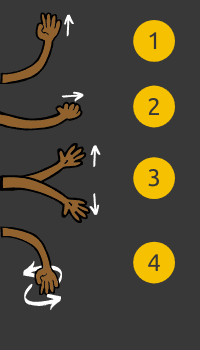
- Stop – place the right arm outside the driver’s window pointing up.
- Turning right – put the right hand in a horizontal position outside the driver’s window.
- Turning left – place the right hand outside the driver’s window and rotate the wrist in an anti-clockwise direction.
- Slowing down/braking – put the right hand outside the driver’s window and wave it up and down in a controlled manner.
Seat belts.
- Drivers must wear seatbelts while driving a vehicle. They must be worn in the front and, if fitted, in the vehicle’s rear.
- If there is no seatbelt for the front passenger seat, then children 14 years of age and younger must sit in the vehicle’s rear.
- The vehicle may not be used on a public road if there are no seat belts in the car.
- Passengers must wear a seat belt if a seat has a seat belt.
- A driver may unfasten a seat belt while parking or reversing.

Reckless and inconsiderate driving.
- Drive off from a stationary position only if it is safe to do so without causing any danger to other traffic (remember defensive driving).
- Do not deliberately disregard the safety of people or property when driving.
- Do not drive recklessly or without consideration for other drivers on the road.
Emergency red triangle.
- At least one double-sided red triangle must appear in all commercial vehicles.
- In an emergency, the triangle must be displayed on the road at least 45 metres behind the vehicle facing oncoming traffic.
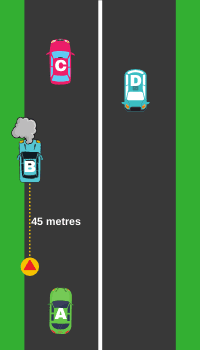
The use of lights.
- When driving between sunset and sunrise, always switch the headlights on.
- The beam must light up objects at least 100 metres ahead.
- If visibility is not clear for at least 150m, drivers must switch on the headlights.
- If traffic is approaching and the brights are on, switch them to the dimmer beam to not affect the vision of other drivers.
- Parking lights may be used in demarcated parking areas or when vehicles get parked 12m or more from a street light.
- Use the emergency warning lights (two flashing indicators) in an emergency only or when your vehicle is in a potentially hazardous position.
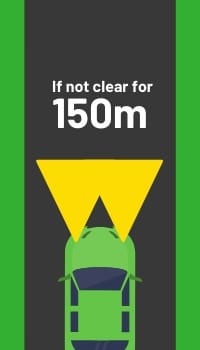
Alcohol and drugs.
A driver may not sit in the driver’s seat while the vehicle’s engine runs under the influence of drugs or alcohol.
Use of roads and freeways.
On a two-way road, keep as far left as possible while remaining in the correct lane not to obstruct oncoming traffic.
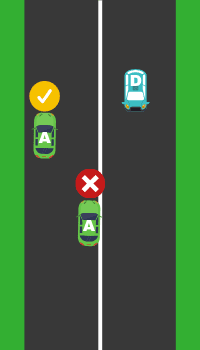
Divided roads.
- If a road gets divided by open space, e.g. grass, an island, or a painted divider, keep to the left.
- A driver may cross a division only at an opening or intersection where a traffic officer or road sign does not prohibit it.

Speed limits.
Non-urban roads:
- Light motor vehicles (LMV) – 100km/h.
- Goods vehicles – 80km/h.
- Vehicles that weigh 9000kg or more – 80km/h.

Urban roads:
- 60km/h for all vehicles.
Freeways:
- Light motor vehicles – 120km/h.
- Buses with passengers – 100km/h.
- Vehicles 9000kg and more – 80km/h.
Passing and overtaking
A driver may overtake a vehicle at any place on the road, provided it is a two-lane road not prohibited by a road sign or road marking.
When overtaking a vehicle in front:
- Pass to the vehicle’s right, be aware of oncoming traffic and practice the defensive driving method.
- Keep a safe distance from the car when overtaking.
- Ensure the vehicle is safely clear of the car overtaken before signalling to move back into the left-hand lane.
- When overtaking a stationary bus, be sure to look for passengers leaving the bus.
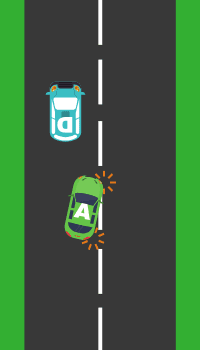
Overtaking on the left
A driver may overtake the vehicle in front on the left when:
- The driver in front has indicated to turn right.
- The road is wide enough to do so.
- The driver does not drive on the left verge or the road’s left shoulder.

Overtaking on a two-way road
- Do not try to overtake on the right-hand side of the road if the view is restricted.
- Never overtake on the right-hand side when approaching the crest of a hill, rise or curve in the road.
- Do not overtake across a solid white line.
- Never overtake when it is prohibited by a traffic sign, signal or road marking.
- Lastly, do not overtake at a scholar patrol or pedestrian crossing.
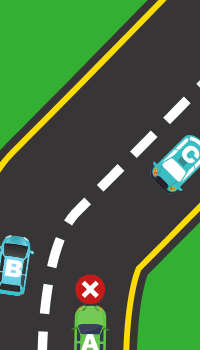


Turning right
- Before turning right, keep close to the centre of the road without touching the dividing line.
- Keeping in the centre also allows vehicles at the rear to pass safely on the left.
